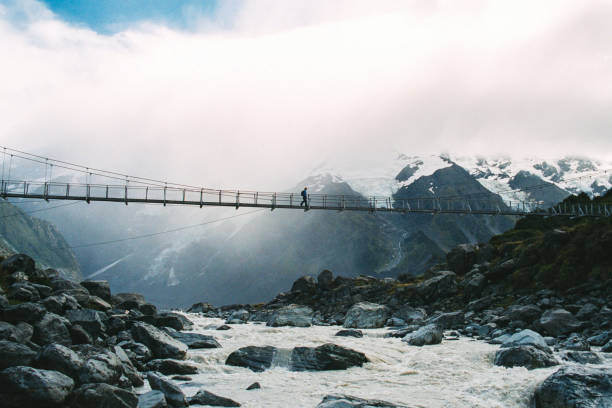The Menai Suspension Bridge was forced to close after engineers ruled that there was a “credible risk of an unzipping failure of the bridge deck [which] may have led to catastrophic loss of life”, NCE can reveal. The 176m-long road bridge spanning mainland Wales and the Isle of Anglesey was closed to all motorised traffic on 21 October 2022. Bridge operator UK Highways A55 reopened it with a 7.5t weight restriction last week following a four-week emergency repair programme carried out by Spencer Group. The 197-year-old bridge was originally designed by Thomas Telford. It consists of two 52.7m high masonry towers which support two sets of steel chains across the 176.7m main span. The approaches are formed of masonry arch viaducts, four spans on the Anglesey side and three spans on the Bangor Mainland side. The deck of the main span is suspended from the chains via vertical spiral strand hangers. In the side spans, vertical hangers also connect the chains to the masonry viaducts and this serves to control the profile of the chain and limit the horizontal movement of the roller saddles at the tower tops. The reason for the closure has remained undisclosed until now. However, a technical briefing document shared with NCE reveals that the issue centred on an “unacceptable risk of brittle failure” in hanger sockets which were installed during a major upgrade of the bridge between 1938 and 1941. The hanger sockets connect the bridge’s 242 hangers with the main suspension chains. The briefing document, based on analysis by Cowi, adds that “were a given hanger to fail in a brittle manner […] the impulse loading from this event had the potential to cause brittle fracture in adjacent hangers, leading to a progressive and disproportionate collapse of the bridge deck”. It adds: “Due to the inherently unpredictable nature of brittle fracture, it is extremely difficult to accurately determine the probability of such an event, but the analysis showed there was a credible risk of an unzipping failure of the bridge deck. Such an event may have led to catastrophic loss of life and was thus considered an unacceptably high consequence event that could have credibly occurred.” The 1938-1941 upgrade was carried out by Dorman Long and involved replacing the entire superstructure including bridge deck, hangers, and chains. The arches on the carriageway were also widened and the footway cantilevers were added to the length of the structure.

Cowi Engineers Who Were Appointed To Repaint The Approach.
span hangers as part of planned maintenance. It was during preparatory inspections for the repainting that Cowi engineers raised concerns regarding the ductility and capacity of the hanger sockets. Cowi senior bridge engineer Sam Wood said: “Heritage bridges like Menai often present difficult challenges, balancing conservation of historic fabric with modern expectations on safety, especially when they are still functional items of infrastructure.” In a bid to get the bridge reopened as quickly as possible, the repair plan was split into two phases. The first phase – which allowed the bridge to reopen – involved installing 106 secondary fail-safe mechanisms between the bridge’s chains and deck which provide additional support in the event of the failure of a primary hanger. The secondary fail-safe mechanisms were installed without the need to remove the hangers and consists of four key features including: wire rope slings basketed over the bridge chain link ends; turnbuckles for adjustment to ensure ‘snug tight’; steel frame under-slung on main-span truss; and special support bracket on the side-span. (see diagram left). The second phase of work will see 168 of the existing hangers removed using a custom designed de-tensioning rig and replace them with new hangers. The de-tensioning rig will be installed inside the fail-safe mechanism from the first phase of works, which will be kept in place throughout the programme. Once the new hangers are installed, the Menai Suspension Bridge will be able to reopen without restriction and the secondary fail-safe system and de-tensioning rig removed with only the new hangers remaining. A spokesperson from Spencer Group said: “Finding a solution to this very unique problem posed a number of complex engineering challenges. We worked extremely closely with UK Highways, the Welsh Government, and the wider project team of engineers to fully understand the issues and constraints, to allow us to develop a solution that is safe and robust for bridge users, and the structure itself, in the fastest possible timescale.” A timeframe for the second phase of repairs has yet to be finalised. However, it is likely to coincide with other upgrades to the bridge to avoid future closures. The Welsh Government deputy minister for climate change with responsibility for transport Lee Waters said: “The Menai Suspension Bridge is one of the best examples of civil engineering in the UK and has been vital to the transport infrastructure for North Wales since Victorian times. “As with any historical structure, wear and tear is inevitable and a potential issue was discovered last year with the bridge deck hangers which necessitated the closure of the bridge for a period, whilst remedial work was carried out. We appreciate the inconvenience this has caused for local people, and we’ve done everything we can to minimise disruption and provide support for businesses impacted by the closure, but safety must come first.”


Recent Comments